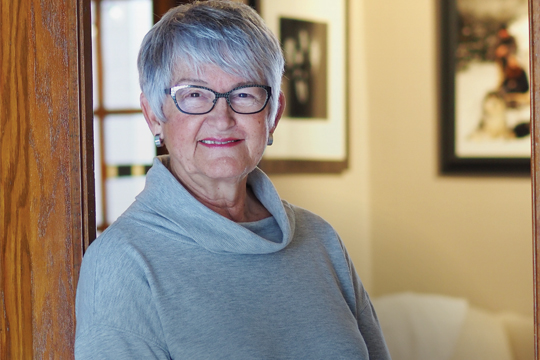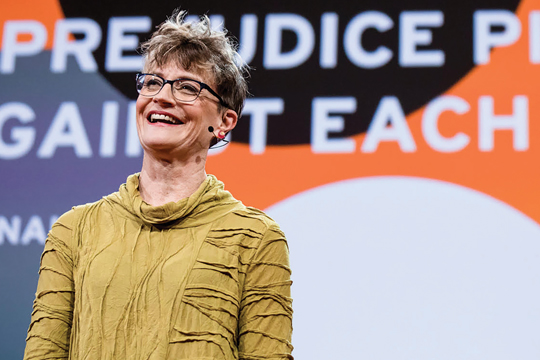
Federal Retirees member Linda MacDonald has waged war on ageism. She has experienced it and she calls it out when she sees it. Photo: Anna Pelletier Doble
Linda MacDonald remembers very clearly one time she experienced ageism. The 73-year-old had been having chest pains so she went to the emergency room. On further investigation, the pain was simply muscle spasms and, as she was leaving, a hospital official came by to interview her, something they do with all patients over the age of 70.
“That was fine — actually, I thought it was a good thing,” she recalls about the interview request. “They do it to make sure that when you go home, you have the support you need.”
The interviewer started with his questions, including asking if she was on any medication. When she said yes, he asked if she “remembered” which one.
“He didn’t even realize what he was saying to me by using that word,” says MacDonald, who formerly served as Ontario District director for Federal Retirees. “But I let him know. I told him the inference is that you think I might not know what [my medication] is, or remember. But very clearly, I did. And as it turned out, he’s on the same one. Those kinds of things are subtle, but they really point to something else.”
That “something else” is ageism, a systemic form of oppression that is very often experienced by older people. It manifests itself in the way people think, in the form of stereotypes; in the way they feel, in the form of prejudice; and in the way they act, in the form of discrimination.
How one experiences ageism and how it is directed is influenced by gender, race and orientation and it can come at us from many sources — marketing, television, movies, media of all forms, government policies and health care delivery. It can be implicit, explicit, institutional and personal.
MacDonald’s other experience with it is more painful than the first. When her mother was in her early 70s, she started to have serious pain, which a doctor diagnosed as arthritis, a common ailment for people her age. After several years of enduring the pain, she became so ill she was hospitalized and doctors soon figured out she had multiple myeloma, a blood cancer that affects the bones in painful ways.
“Had they not assumed her symptoms were arthritis, because she was in her early 70s, she would have been diagnosed months, if not years, in advance and she would have been spared a great deal of pain,” MacDonald says. “That’s the kind of thing that really worries me. And it should worry a lot of people.”

Author Ashton Applewhite started researching ageism when she started noticing it herself.
Anger over ageism
Ashton Applewhite, author of This Chair Rocks: A Manifesto Against Ageism, was inspired to research ageism out of anger.
“I realized I was getting old and I started looking into oldness and realized that my fears were legitimate,” Applewhite says. “I became obsessed with why we never talked about both sides of the story. I’ve come to [better] understand how prejudice works.”
Applewhite, whose website is thischairrocks.com and who publishes a Q&A advice column called “Yo, Is this Ageist?” on her website, says the single most effective argument for dismantling ageism is the prospective health benefits of a world without it.
In its landmark 2021 Global Report on Ageism, the World Health Organization (WHO) states that ageism is associated with a shorter lifespan, poorer physical and mental health, slower recovery from disability as well as cognitive decline.
It continues: “Ageism reduces older people’s quality of life, increases their social isolation and loneliness (both of which are associated with serious health problems), restricts their ability to express their sexuality and may increase the risk of violence and abuse against older people.”
The report also quotes a “recent estimate” showing that ageism costs society billions of dollars.
Applewhite also likes a study done by Becca Levy, professor of public health and psychology at the Yale Institute for Global Health. Levy found that people with positive (though Applewhite prefers the term accurate over positive) attitudes toward aging live 7.5 years longer than those with poor attitudes.
A similar study by the Annenberg Public Policy Center and AARP found that the more one knows about aging, the less fear it holds and that learning about aging reduces anxiety about it. Only hearing the “scary” aspects isn’t healthy, as Applewhite puts it.
“I am not a Pollyanna,” Applewhite says. “It’s super important to address the fact that many of our fears [about aging] are completely legitimate, but much of what we think of as ageism is actually ableism [discrimination in favour of able-bodied people.] It’s stigma.”
Federal Retirees’ fight
In the summer of 2022, Federal Retirees took the historic step of joining the Global Alliance for the Rights of Older People (GAROP) and collaborated with the International Longevity Centre Canada to establish the Canadian Coalition against Ageism, a group that is now lobbying the United Nations to introduce a UN Convention on the Rights of Older Persons. The convention was among the recommendations in the WHO’s report on ageism. The UN has already made this decade the UN Decade of Healthy Aging, which may help forge the path.
Anthony Pizzino, CEO of Federal Retirees, is making raising awareness about ageism a priority for the organization.
“Older Canadians are tired of this stigma,” Pizzino says. “We need to call out ageism when we see it, and we need concerted government actions to support those efforts. We need a change of perspective to eliminate stereotypes of older persons being a weak, dependent and non-contributing part of society.”
Leslie Gaudette, who has volunteered for Federal Retirees in many capacities, is helping to move this initiative along in her province of British Columbia. She says you see ageism even in volunteer opportunities.
"Ageism reduces older people’s quality of life, increases their social isolation and loneliness… restricts their ability to express their sexuality and may increase the risk of violence and abuse against older people."
“When you get to be about 50, often your responsibilities decrease, and you have time to pursue things that you were interested in, but couldn’t do before,” Gaudette says. “But there’s a failure to recognize that a person in their 50s may have 20 or 30 quality years — or even longer — to contribute. That’s a lot of time.”
She recalls one group she joined that was looking for 30-year-olds to volunteer, though it had women into their 80s who were still contributing at a high level.
“Even if there are sometimes some physical limitations, mentally, there are none,” she says. “And [older people] have all this experience in planning and organizing and wisdom and connections they can bring that can be really helpful.”
Ideas for eradication
The WHO recommends three strategies that have worked to help eradicate ageism. The first suggests “policies and legislation that address age discrimination and inequality in human rights law.” The second is “educational activities [to] help enhance empathy, dispel misconceptions about different age groups and reduce prejudice and discrimination by providing accurate information and counter-stereotypical examples.” Finally, it recommends inter-generational contact that can “reduce inter-group prejudice and stereotypes” to reduce ageism across the spectrum.
Applewhite also has some “antidotes.” She says awareness is the critical starting point because society needs to acknowledge its own prejudices about age and aging. Even MacDonald recognizes that she has some ingrained prejudices on the subject, in spite of being an anti-ageism warrior.
Like the WHO, Applewhite also suggests connecting with people of all ages because “an equitable society for all ages requires intergenerational collaboration.” And, she recommends activism. “Watch for ageist behaviours and attitudes, challenge them and create language and models that support every stage of life.”

